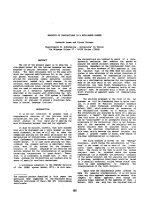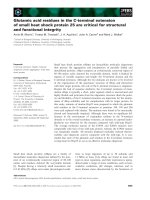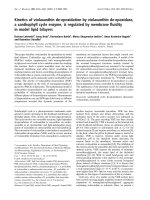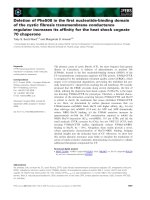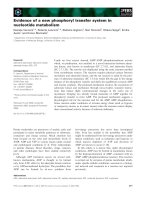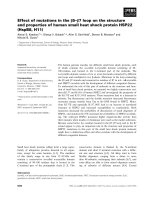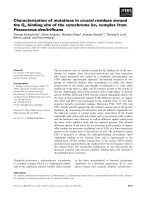Báo cáo khoa học: "Evidence of recombination in Hepatitis C Virus populations infecting a hemophiliac patient" pdf
Bạn đang xem bản rút gọn của tài liệu. Xem và tải ngay bản đầy đủ của tài liệu tại đây (859.54 KB, 9 trang )
BioMed Central
Page 1 of 9
(page number not for citation purposes)
Virology Journal
Open Access
Research
Evidence of recombination in Hepatitis C Virus populations
infecting a hemophiliac patient
Pilar Moreno
1
, Macarena Alvarez
1
, Lilia López
1,2
, Gonzalo Moratorio
1
,
Didier Casane
3
, Matías Castells
1
, Silvia Castro
4
, Juan Cristina
1
and
Rodney Colina*
1
Address:
1
Laboratorio de Virología Molecular, Centro de Investigaciones Nucleares, Facultad de Ciencias, Universidad de la República,
Montevideo, Uruguay,
2
Servicio Nacional de Sangre, Montevideo, Uruguay,
3
Laboratoire Evolution Génomes Spéciation, CNRS 91198 Gif-sur-
Yvette, France and
4
Cátedra de hemoterapia, Hospital de Clínicas, Montevideo, Uruguay
Email: Pilar Moreno - ; Macarena Alvarez - ; Lilia López - ;
Gonzalo Moratorio - ; Didier Casane - ; Matías Castells - ;
Silvia Castro - ; Juan Cristina - ; Rodney Colina* -
* Corresponding author
Abstract
Background/Aim: Hepatitis C virus (HCV) infection is an important cause of morbidity and
mortality in patients affected by hereditary bleeding disorders. HCV, as others RNA virus, exploit
all possible mechanisms of genetic variation to ensure their survival, such as recombination and
mutation. In order to gain insight into the genetic variability of HCV virus strains circulating in
hemophiliac patients, we have performed a phylogenetic analysis of HCV strains isolated from 10
patients with this kind of pathology.
Methods: Putative recombinant sequence was identified with the use of GARD program.
Statistical support for the presence of a recombination event was done by the use of LARD
program.
Results: A new intragenotypic recombinant strain (1b/1a) was detected in 1 out of the 10
hemophiliac patient studied. The recombination event was located at position 387 of the HCV
genome (relative to strain AF009606, sub-type 1a) corresponding to the core gene region.
Conclusion: Although recombination may not appear to be common among natural populations
of HCV it should be considered as a possible mechanism for generating genetic diversity in
hemophiliacs patients.
Background
Hepatitis C virus (HCV) is estimated to infect 170 million
people worldwide and is the major causative agent of post
transfusional hepatitis and parenterally transmitted spo-
radic non A non B Hepatitis [1]. Hemophiliacs and other
patients with inherited bleeding disorders treated with
non-inactivated clotting factor concentrates prior to the
mid 1980 are at particular risk for acquiring HCV infec-
tion. Each clotting factor concentrated were made from
plasma pools prepared from approximately 20000 blood
donors at a time and this provided a single unit risk of
infection of 5%. The introduction of inactivation proce-
Published: 18 November 2009
Virology Journal 2009, 6:203 doi:10.1186/1743-422X-6-203
Received: 23 September 2009
Accepted: 18 November 2009
This article is available from: />© 2009 Moreno et al; licensee BioMed Central Ltd.
This is an Open Access article distributed under the terms of the Creative Commons Attribution License ( />),
which permits unrestricted use, distribution, and reproduction in any medium, provided the original work is properly cited.
Virology Journal 2009, 6:203 />Page 2 of 9
(page number not for citation purposes)
dures and blood donor screening for HCV has dramati-
cally improved the safety of pooled plasma products [2,3].
In Uruguay hemophiliac patients were treated with fresh
frozen plasma in the 60 s and with cryoprecipitate (VIII
factor and fibrinogen rich fraction plasma) since the 70 s,
these transfusions were responsible for most of hepatitis
C transmission in hemophiliac. Since the 70 s and mid 80
s, industrial non-inactivated clotting factor was available
in the world but this product was not used in Uruguay
until the 90 s [4].
HCV is a member of the family Flaviviridae. HCV is a sin-
gle stranded, positive sense, RNA virus with a genome of
approximately 9400 bp [1,5]. Comparison of nucleotide
sequences of variants recovered from different individuals
around the world has revealed the existence of at least six
major genetic groups and an increasing number of sub-
types [1,6-8]. Since hemophiliacs were infected by clotting
factors concentrates manufactured from many thousands
of blood donors, the HCV genotype distribution may
reflect that of the donor population. Besides, different
HCV genotypes may have infected the same patient
[3,9,10].
HCV as others RNA virus exploit all possible mechanisms
of genetic variation to ensure their survival. The high rate
of mutation generated by the polymerase and the high
rate of replication of this virus results in the circulation in
vivo of complex population of different but closely related
viral variants, commonly referred to as a quasispecies [11-
13]. It is known that recombination plays a significant
role in the evolution of RNA viruses by creating genetic
variation. Both inter and intragenotypic recombination
have been reported in HCV populations in different geo-
graphic locations like Russia (2 k/1b) [14,15], Peru (1a/
1b) [16], Vietnam (2/6) [17], Philippines (2b/1b) [18],
France (2/5) [19], Uzbekistan (2 k/1b) [20], Japan (1a/1c)
[21] and Ireland [22]. Intra-patient recombination has
also been reported [23,24].
In order to gain insight into the possible role of recombi-
nation in shaping the HCV evolution in hemophiliac
patients, we have performed a phylogenetic analysis of
HCV strains circulating in Uruguayan patients with clini-
cal diagnosis of this disease. The results of these studies
revealed for the first time the presence of a natural
intragenotypic HCV recombinant strain circulating in a
Uruguayan hemophiliac patient.
Results
To gain insight into the genetic variability of HCV strains
circulating in Uruguayan hemophiliac patients, we first
obtained nucleotide sequences from five different
genomic regions of the HCV genome from strains circulat-
ing in these patients. These sequences were aligned with
corresponding sequences from 35 HCV strains of all types
and sub-types isolated in different geographic regions of
the world, obtained using the HCV LANL database [25].
The origin of the sequences and the strains used are listed
in Table 1. Sequences were aligned using the CLUSTAL W
program [26]. Once aligned, we first determined the evo-
lutionary model that best fit our sequence data. Akaike
Information Criteria and Hierarchical Likelihood Ratio
Test showed that the General Time Reversible (GTR) plus
gamma model best fit our sequence data. Using this
model, maximum likelihood phylogenetic trees were cre-
ated for the 5'NCR and the core region. The results of these
studies are shown in Figure 1. All strains in the tree are
assigned according with their genotype. Each cluster is
supported by very high aLRT values (see Figure 1). Inter-
estingly, Uruguayan strain H23, assigned to subtype 1b in
the 5'NCR region, is assigned to subtype 1a in the core
region (compare Figs. 1A and 1B) [GenBank: EU934902
-
EU934907
].
The same studies were done for the E2, NS5A and NS5B
regions of the HCV genome. The results of these studies
revealed that Uruguayan strain H23 is assigned to subtype
1a in these regions (data not shown).
To rule out that this results were the consequence of the
co-infection of the patient with two different HCV sub-
types and not really a recombinant strain, we amplified by
PCR the 5'NCR-core region of HCV strain H23 (from
nucleotide 9 to 706, relative to the genome of HCV strain
AF009606). Once amplified, sequences from that region
of the genome of strain H23 were obtained by direct
sequencing of the PCR fragment using the same primers
used for amplification. Sequences from the 5'NCR-core
region of HCV H23 strain were aligned with correspond-
ing sequences from the genotype 1 HCV strains shown in
Figure 1 using CLUSTAL W program [26] (see also Table
1). Once aligned, we used GARD to determine the pres-
ence of possible recombination break-points [27]. A
recombination break-point is observed at position 379 of
the alignment, representing position 387 of the HCV
genome which corresponds to position 46 of HCV core
gene (relative to strain AF009606) (see Figure 2). Two
putative parental-like strains D11355 (subtype 1b) and
AF009606 (subtype 1a) were identified.
In order to confirm the results obtained using the GARD
approach, sequence alignment between H23 and its puta-
tive parental-like strains D11355 (subtype 1b) and
AF009606 (subtype 1a) around the breakpoint were per-
formed and maximum likelihood phylogenetic trees were
constructed for the sequence alignment before and after
the identified breakpoint. The results of these studies are
shown in Figure 3. As it can be seen in the figure 3B, Uru-
guayan H23 strain is assigned to subtype 1b using the
Virology Journal 2009, 6:203 />Page 3 of 9
(page number not for citation purposes)
alignment from positions 9 to 386, and to subtype 1a
from positions 387 to 706. To confirm that the recombi-
nation model we obtained gave a significant better fit to
the data than the null hypothesis of no recombination, we
used LARD program [28] employing a different dataset of
putative parental-like HCV 1a and 1b strains. The results
of these studies are shown in Figure S1 (see Additional
File 1). Simulations of sequence evolution under the null
hypothesis (i.e., no recombination) gave strong statistical
support for the alternative hypothesis of recombination
(P < 0.001).
Maximum likelihood phylogenetic tree analysis of HCV strains using the GTR plus gamma modelFigure 1
Maximum likelihood phylogenetic tree analysis of HCV strains using the GTR plus gamma model. Strains in the
tree are shown by their accession number and their genotypes are indicated between parentheses for strains previously
described (for accession numbers, genotypes and geographic origin of isolation see Table 1). Strain H23, isolated from a Uru-
guayan hemophiliac patient is shown by name. Numbers at each branch of the tree show aLRT values. Bars at the bottom of
the trees show distance. The phylogeny for the 5'NCR and core region is shown in (A) and (B) respectively.
Virology Journal 2009, 6:203 />Page 4 of 9
(page number not for citation purposes)
Table 1: Origins of hepatitis C virus strains from LANL database.
Strain Name Genotype Geographic location Accession number
HCV-A 1b Australia AJ000009
JT 1b Japan D11355
HCV-AD78 1b Germany AJ132996
HC-J4 1b Japan D00832
HCR6 1b Japan AY045702
HC-C2 1b China D10934
DQ071885 1b Taiwan DQ071885
HCU16362 1b Korea U16362
HCVT212 1b Japan AB049099
HEBEI 1b China L02836
H77C 1a United States AF011751
HCV-H 1a United States M67463
HC-J1 1a Japan D10749
1013_FU24 1a United States EU362876
7065 1a United States EF407455
H77 1a United State AF009606
FR5 2a France L38334
NDM59 2a Japan AF169005
JCH-6 2a Japan AB047645
HC-J7 2b Japan D10077
MD2B-1 2b Japan AF238486
TN9-0FL 2b United State DQ430815
HPCSTRUCTC 3a France L12355
NB125 3a India AY231596
HCVCENS1 3a Germany X76918
NB134 3b India AY231588
Th527 3b Thailand D37839
NE137 3b Nepal D16616
ED43 4a Egypt Y11604
HEMA51 4a Japan D45193
Virology Journal 2009, 6:203 />Page 5 of 9
(page number not for citation purposes)
To further characterize the presence of the recombination
event in Uruguayan HCV H23 strain by other methods,
we employed the Genotyping Tool of NCBI server [29]. As
it can be seen in Figure S2 (see Additional File 2) and in
Table S3 (see Additional File 3), the BLAST scores
obtained in this analysis show the presence of a recombi-
nation event in HCV H23 strain.
Discussion
Previous results have consistently given congruent results
for HCV genotyping using different genomic regions [8].
In this study, incongruent results were found for one HCV
strain circulating in a hemophiliac patient when different
genomic regions were used (see Figure 1). This apparent
discrepancy was due to the fact of the presence of a recom-
bination break-point in HCV Uruguayan strain H23 at
position 387 of HCV genome (relative to strain
AF009606) (see Figure 2). Maximum likelihood phyloge-
netic tree analysis were performed using partial align-
ments of the same sequences before and after the
identified break-point which support the presence of a
recombination event at this position (see Figure 3). More-
over, this recombination model has a better statistically
support against the null hypothesis of no recombination
(see Figure S1 in Additional File 1). Furthermore, using a
different set of putative parental-like strains, the Genotyp-
ing Tool results revealed BLAST scores that also support
SA13 5a South Africa AF064490
EUH1480 5a United Kingdom Y13184
VN11 6a Vietnam L38339
EUHK2 6a China Y12083
6a73 6a China DQ480517
Table 1: Origins of hepatitis C virus strains from LANL database. (Continued)
Recombination break-point detection using GARDFigure 2
Recombination break-point detection using GARD. Support probability for inferred recombination break-points is
shown on the left side of the figure. The nucleotide position in the alignment is shown on the x-axis of the graph.
Virology Journal 2009, 6:203 />Page 6 of 9
(page number not for citation purposes)
Identification of recombination break-point in Uruguayan H23 HCV strainFigure 3
Identification of recombination break-point in Uruguayan H23 HCV strain. In (A) an alignment of 5'NCR plus core
sequences of strains H23 and parental-like strains D11355 (sub-type 1b) and AF009606 (sub-type 1a) is shown. Identity to H23
is shown by a dash. Recombination break-point identified by GARD is shown by an arrow. In (B) a scheme representing H23
5'NCR plus core region sequences showing the recombination break-point is shown in the upper part of the figure. Numbers
indicate nucleotide positions relative to strain AF009606. Maximum likelihood phylogenetic trees obtained using partial align-
ment before and after the recombination break-point are shown behind the scheme. Strains previously described are shown by
their accession number and their genotype is indicated between parenthesis (see also Table 1). Strain H23 is shown by name
and indicated by an arrow. Numbers at each branch of the trees show aLRT values. Bars at the bottom of the trees show dis-
tance.
Virology Journal 2009, 6:203 />Page 7 of 9
(page number not for citation purposes)
the recombination event (see Figure S2 in Additional File
2 and Table S3 in Additional File 3).
Previous HCV phylogenetic studies have shown that
recombination breakpoints can be detected in non struc-
tural and structural regions of the HCV genome [14-22].
Interestingly, the recombination breakpoint identified in
Uruguayan strain H23 is located inside the core Region.
Although recombination does not seem to be a common
event in the evolution of the HCV populations, the results
of these studies reveal that recombination can be consid-
ered as an evolutionary mechanism for generating genetic
diversity in HCV populations circulating in Hemophiliac
patients. Due to the fact that these Hemophiliac patients
have been transfused many times, the possibility of being
infected by two different HCV genotypes and subtypes is
higher than in other kind of patients, increasing the pos-
sibility of a recombination event to take place.
Conclusion
Given the implications of recombination for virus evolu-
tion and the development of vaccines, virus control pro-
grams, patient management and antiviral therapies, it is
clearly important to determine the extent to which recom-
bination plays a role in HCV evolution. This study dem-
onstrates the presence of a recombinant 1b/1a HCV strain
circulating in a hemophilic patient. Further studies will be
needed in order to establish the role of recombination
events in shaping the HCV evolution in hemophiliac
patients.
Methods
Serum samples
Serum samples were obtained from 10 Hemophiliac
patients with serological markers for HCV from the Hos-
pital de Clínicas (Montevideo, Uruguay). Patients were
screened using Riba-ELISA according to the manufac-
turer's instructions.
RNA extraction, cDNA synthesis and amplification
HCV RNA was extracted from 140 μl serum samples with
the QIAamp viral RNA Kit (QIAgen) according to the
manufacturer's instruction. The extracted RNA was eluted
from the columns with 50 μl RNAse free water. cDNA syn-
thesis and PCR amplification of the 5' non-coding region
(5'NCR), core, E2, NS5a and NS5b were carried out as pre-
viously described [30,31]. The 5'NCR-core PCR from
strain H23 (from nucleotide 9 to 706, relative to the
genome of HCV strain AF009606) was performed as pre-
viously described [32]. Amplicons were purified using the
DNA extraction Kit (Fermentas).
Sequencing
The same primers of the PCR were used for sequencing the
PCR fragments of each region. The sequencing reaction
was done in both strands, and was carried out using the
Big Dye DNA sequencing Kit (Perkin Elmer) on a DNA
sequencing apparatus ABI3130 (Perkin Elmer).
Sequence analysis
5'NCR, core, E2, NS5a and NS5b sequences obtained from
Uruguayan hemophiliac patients were aligned with corre-
sponding sequences from strains from all HCV genotypes
and sub-types, isolated in different geographic regions of
the world. Sequences were obtained using the HCV LANL
database (see Table 1) [25]. Sequences were aligned using
the CLUSTAL W program [26]. Once aligned, the best evo-
lutionary model that describe our sequence data was
assessed using the Modelgenerator [33] (Akaike Informa-
tion Criteria and Hierarchical Likelihood Ratio test indi-
cated that the GTR plus gamma model was the most
appropriate model to represent the sequence data). Using
this model, maximum likelihood phylogenetic trees were
constructed using the PhyML program [34,35]. As a meas-
ure of the robustness of each node, we employed an
approximate Likelihood Ratio Test (aLRT), that assesses
that the branch being studied provides a significant likeli-
hood gain, in comparison with the null hypothesis that
involves collapsing that branch but leaving the rest of the
tree topology identical [36].
Genetic Algorithm Recombination Detection (GARD)
Analysis
To detect possible recombination events we used GARD
method (available at />GARD/) for detecting discordant phylogenetic signal in
sequence alignments, which provides estimates of the
number and location of break points and segment-spe-
cific phylogenetic trees [27].
Genotyping tool at NCBI
To detect possible HCV recombinant strain sequences, we
used Genotyping Tool at the National Center for Biotech-
nology Information (available at: http://
www.ncbi.nih.gov/projects/genotyping/formpage.cgi).
This approach uses BLAST to compare a query sequence to
a set of HCV reference sequences of known genotypes and
sub-types. The query sequence is broken into segments for
comparison to the reference so that the mosaic organiza-
tion of recombinant sequences could be revealed [29].
LARD (Likelihood Analysis of Recombination in DNA)
analysis
To assess whether the recombination model we obtained
gave a significantly better fit to the data than the null
hypothesis of no recombination, we used LARD program
[28]. Briefly, for every possible breakpoint, the sequence
Virology Journal 2009, 6:203 />Page 8 of 9
(page number not for citation purposes)
alignment was divided into two independent regions for
which the branch lengths of a tree of the putative recom-
binant and its two parent sequences were optimized. The
two results (likelihoods) obtained by using the separate
regions were then combined to give a likelihood score for
that breakpoint position and the breakpoint position that
yielded the highest likelihood then was compared, by
using a likelihood ratio test, to the likelihood obtained
from the same data under a model that permitted no
recombination. The likelihood ratio obtained by using
the real data were evaluated for significance against a null
distribution of likelihood ratios produced by using Monte
Carlo simulation of sequences generated without recom-
bination. Sequences were simulated 1,000 times by using
the maximum likelihood model parameters and sequence
lengths from the real data using Seq-Gen [37].
List of Abbreviations
aLTR: approximate Likelihood Ratio Test; GARD: Genetic
Algorithm Recombination Detection Analysis; GTR: Gen-
eral Time Reversible; HCV: Hepatitis C Virus; IFN: Inter-
feron; LARD: Likelihood Analysis of Recombination in
DNA; 5'NCR: 5'Non Coding Region.
Competing interests
The authors declare that they have no competing interests.
Authors' contributions
PM and MA conceived the study. PM, LL, SC and GM
designed the analysis. JC and PM performed the recom-
binant studies. DC performed the LARD analysis. JC and
RC contributed to the discussion of all results found in
this work. PM and RC wrote the paper. All authors read
and approved the final manuscript.
Additional material
Acknowledgements
This work was supported by Fondo Clemente Estable (Uruguay) through
Proyect 05/039. PM thank PEDECIBA, Uruguay, for support.
References
1. Simmonds P: Genetic diversity and evolution of hepatitis C
virus 15 years on. J Gen Virol 2004, 85:3173-3188.
2. Aach RD, Szmuness W, Mosley JW, Hollinger FB, Khan RA, Stevens
CE, Edwuards VM, Werch J: Serum alanine aminotransferase of
donors in relation to the risk of non-A non-B hepatitis in
recipients: the transfusion-Transmitted viruses. N Engl J Med
1981, 304:989-994.
3. Franchini M, Capra F, Tagliarferri A, Rossetti G, De Gioroncoli M,
Rocca P, Aprili G, Gandini G: Update on Chronic hepatitis C in
Hemophiliacs. Haematologica 2002, 87:542-549.
4. López L, López P, Arago A, Rodríguez I, López J, Lima E, Insagaray J,
Bentancor N: Risk factors for hepatitis B and C in multi-trans-
fused patients in Uruguay. J Clin Virol 2005, 34:69-74.
5. Okamoto HS, Okada S, Sugiyama Y, Kurai K, Lizuka H, Machida A,
Miyakawa Y, Mayumi M: Nucleotide sequence of the genomic
RNA of hepatitis C virus isolated from a human carrier: com-
parison with reported isolates from conserved and divergent
regions. J Gen Virol 1991, 72:2697-2704.
6. Simmonds P: The origin and evolution of hepatitis viruses in
humans. J Gen Virol 2001, 82:693-712.
7. Simmonds P, Holmes EC, Cha TA, Chan SW, McOmish F, Irvine B,
Beall E, Yap PL, Kolberg J, Urdea MS: Classification of hepatitis C
virus into six major genotypes and a series of subtypes by
phylogenetic analysis of the NS-5 region. J Gen Virol 1993,
74:2391-2399.
8. Simmonds P, Bukh J, Combet C, Deleage G, Enomoto N, Feinstone S,
Halfon P, Inchauspe G, Kuiken C, Maertens G, Mizokami M, Murphy
DG, Okamoto H, Pawlotsky JM, Penin F, Sablon E, Shin IT, Stuyver LJ,
Thiel HJ, Viazov S, Weiner AJ, Widell A: Consensus proposals for
a unified system of nomenclature of hepatitis C virus geno-
types. Hematology 2005, 42:962-973.
9. Jarvis LM, Ludlam CA, Simmonds P: Hepatitis C virus genotypes
in multitransfused individuals. Hemophilic 1995, 1:3-7.
10. Zoulim F: Hepatitis C virus infection in special groups. J Hepa-
tol 1999, 31:130-135.
11. Laskus T, Wilkinson J, Gallegos-Orozco JF, Radkowski M, Adair DM,
Nowicki M, Operskalsi E, Buskell Z, Seeff LB, Vargas H, Rakela J:
Analysis of hepatitis C virus quasispecies transmission and
Additional file 1
Distribution of the likelihood ratios expected by chance. An alignment
of the 5'NCR plus Core region of the sequences corresponding to strain
H23 and putative parental like strains D11355 (sub-type 1b), and
AF009606 (sub-type 1a) was used in this study. The distribution of the
likelihood ratios for the null hypothesis (i. e. no recombination) is shown.
The y-axis shows the number of simulations. Likelihood ratios are shown
at the bottom of the figure. The arrow show the likelihood ratio obtained
for the real dataset for the putative recombinant strain.
Click here for file
[ />422X-6-203-S1.PDF]
Additional file 2
Results of Genotyping tool at NCBI. A graphic output of the analysis of
1b/1a recombinant strain H23 using a window of 200 bases and a move-
ment of 10 bases is show. In the upper part of the figure a schematic rep-
resentation of the mosaic H23 strain sequences is shown and the colors
indicate the corresponding HCV subtype identified by NCBI database.
BLAST scores are indicated in the left side of the figure. Positions in the
sequence alignment are shown at the bottom. Colors correspond to the dif-
ferent HCV subtypes and are indicated at the right side of the figure. See
also Table S3 (Additional File 3).
Click here for file
[ />422X-6-203-S2.PDF]
Additional file 3
Table with results for H23 strain using Genotyping Tool at NCBI. The
table shows the results for H23 strain using Genotyping Tool as imple-
mented in NCBI. The position alignment, the blast score, the genotype
and G.I. of the reference strain are indicated.
Click here for file
[ />422X-6-203-S3.DOC]
Publish with BioMed Central and every
scientist can read your work free of charge
"BioMed Central will be the most significant development for
disseminating the results of biomedical research in our lifetime."
Sir Paul Nurse, Cancer Research UK
Your research papers will be:
available free of charge to the entire biomedical community
peer reviewed and published immediately upon acceptance
cited in PubMed and archived on PubMed Central
yours — you keep the copyright
Submit your manuscript here:
/>BioMedcentral
Virology Journal 2009, 6:203 />Page 9 of 9
(page number not for citation purposes)
evolution in patients infected through blood transfusion. Gas-
troenterology 2004, 127:764-776.
12. Feliu A, Gay E, Garcia-Retortillo M, Saiz JC, Foms X: Evolution of
hepatitis C virus quasispecies immediately following liver
transplantation. Liver Transplant 2004, 10:1131-1139.
13. Martell M, Esteban JL, Quer J, Genesca J, Weiner A, Esteban R, Guar-
dia J, Gomez J: Hepatitis C virus (HCV) circulates as a popula-
tion of different but closely related genomes: quasispecies
nature of HCV genome distribution. J Virol 1992, 66:3225-3229.
14. Kalinina O, Norder H, Mukomolov S, Magnius LO: A natural
intergenotypic recombinant of hepatitis C virus identified in
St. Petersburg. J Virol 2002, 76:4034-4043.
15. Kalinina O, Norder H, Magnius O: Full-length open reading
frame of a recombinant hepatitis C virus strain from St.
Petersburg: proposed mechanism of its formation. J Gen Virol
2004, 85:1853-1857.
16. Colina R, Casane D, Vasquez S, Garcia-Aguirre L, Chunga A, Romero
H, Khan B, Cristina J: Evidence of intratypic recombination in
natural populations of hepatitis C virus. J Gen Virol 2004,
85:31-37.
17. Noppornpanth S, Lien TX, Poovorawan Y, Smith SL, Osterhaus AD,
Haagmans BL: Identification of a naturally occurring recombi-
nation genotype 2/6 Hepatitis C virus. J Virol 2006,
80:7569-7577.
18. Kageyama S, Agdamag DM, Alesna ET, Leano PS, Heredia AM, Abel-
lanosa-Tac-An IP, Jereza LD, Tanimoto T, Yamamura J, Ichimura H: A
natural inter-genotypic (2b/1a) recombinant of hepatitis C
virus in the Philippines. J Med Virol 2006, 78:1423-1428.
19. Legrand-Abravanel F, Cloudien J, Nicot F, Doubois M, Chapuy S, San-
dres-Saune K, Pasquier C, Izopet J: New Natural Intergenotypic
(2/5) recombinant of Hepatitis C virus. J Virol 2007,
81:4357-4362.
20. Kurbanov F, Tanaka Y, Avazova D, Khan A, Sugauchi F, Kan N, Kurb-
anova-Khudayberganova D, Khikmatullaeva A, Musabaev E, Mizokami
M: Detection of hepatitis C virus natural recombinant RF1_2
k/1b strain among intravenous drug users in Uzbekistan.
Hepatol Res 2008, 8:457-464.
21. Cristina J, Colina R: Evidence of structural genomic region
recombination in Hepatitis C virus. Virol J 2006, 3:53.
22. Moreau I, Hegarty S, Levis J, Sheehy P, Crosbie O, Kenny-Walsh E,
Fanning L: Serendipitous identification of natural intergeno-
typic recombinants of HCV in Ireland. Virol J 2006, 3:95.
23. Moreno MP, Casane D, Lopez L, Cristina J: Evidence of recombi-
nation in quasispecies populations of an Hepatitis C Virus
patient undergoing antiviral therapy. Virol J 2006, 3:87.
24. Sentandreu V, Jimenez-Hernandez N, Torres-Puente M, Bracho MA,
Valero A, Gosalbes MJ, Ortega E, Moya A, Gonzalez-Candelas F: Evi-
dence of recombination in intrapatient populations of Hepa-
titis C Virus. Plos one 2008, 3:e3239.
25. Kuiken C, Yusim K, Boykin L, Richardon R: The Los Alamos hep-
atitis C sequence database. Bioinformatics 2005, 21:379-384.
26. Thompson JD, Higgins DG, Gibson TJ: CLUSTAL W: improving
the sensitivity of progressive multiple sequence alignment
through sequence weighting, position-specific gap penalties
and weight matrix choice. Nucleic Acid Research 1994,
22:4673-4680.
27. Kosakovsky Pond SL, Posada D, Gravenor MB, Woelk CH, Frost SD:
Automated Phylogenetic Detection of Recombinant Using a
Genetic Algorithm. Mol Biol Evol 2006, 23:1891-1901.
28. Holmes EC, Worobey M, Rambaut A: Phylogenetic evidence for
recombination in dengue virus. Mol Biol Evol 1999, 16:405-406.
29. Rozanov M, Plikat U, Chappey C, Kochergin A, Tatusova T: A web-
based genotyping resource for viral sequences. Nucleic Acids
Res 2004, 32:W654-W659.
30. Chan S, Mc Omish F, Holmes EC, Dow B, Peutherer JF, Follet E, Yap
PL, Simmonds P: Analysis of a new hepatitis c Type and its phy-
logenetic relationship to exisiting variants. J Gen Virol
1992,
73:1131-1141.
31. Norder H, Bergstrom A, Uhnoo I, Alden J, Weiss L, Czajkowiski J,
Magnius L: Confirmation of nosocomial transmission of hepa-
titis C virus by Phylogenetic analysis of the NS5b. J Clin Micro-
biol 1998, 36:3066-3069.
32. Bracho MA, Carrillo Cruz FY, Ortega E, Moya A, Gonzalez-Candelas
F: A new syubtype of hepatitis C virus genotype 1: complete
genome and phylogenetic relationships of an Equatorial
Guinea isolate. J Gen Virol 2006, 87:1697-1702.
33. Keane TM, Creevey CJ, Pentony MM, Naughton TJ, McInerney JO:
Assessment of methods of amino acid matrix selection and
their use on empirical data shows that ad hoc assumptions
for choice of matrix are not justified. BMC Evol Biol 2006, 6:29.
34. Guindon S, Gascuel O: A simple, fast, and accurate algorithm
to estimate large phylogenies by maximum likelihood. Syst
Biol 2003, 5:696-7042.
35. Dereeper A, Guignon V, Blanc G, Audic S, Buffet S, Chevent F,
Dufayard JF, Guindon S, Lefort V, Lescot M, Clavier JM, Gascuel O:
Phylogeny.fr: robust phylogenetic analysis for the non-spe-
cialist. Nucleic Acids Res 2008, 36:W465-W469.
36. Anisimova M, Gascuel O: Approximate likelihood ratio test for
branchs: A fast, accurate and powerful alternative. Syst Biol
2006, 4:539-52.
37. Rambaut A, Grassly NC: Seq-Gen: an application for the Monte
Carlo simulation of DNA sequence evolution along phyloge-
netic trees. Comput Appl Biosci 1997, 13:235-238.
